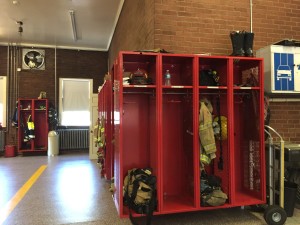
by Ellie Blaser
Over the last five to 10 years, various types of growth have occurred in the city and county of Fredrick, Maryland, including population growth and comprehensive plan and zoning growth. As a result of this, the Frederick City Fire Department has had a larger population to respond to, and at times has had trouble responding to fire on time.
“We are currently one of the second largest regions in the state behind Baltimore, and with that comes the increase call wave,” says Kevin Fox, Battalion Chief with Division of Fire Rescue Services.
This increase in population has been recent. According to Google population records, Frederick City’s population was at 58,643 in 2006, and has since has up to be 66,839. From a larger perspective, this is a stark contrast to the increase since 1990, when Frederick City’s population was 40,795.
“Our call loads have increased,” says Fox. “A few years ago we normally ran about 20,000 a year, and now we’re up over 30,000 calls a year.”
When a fire hits someone’s home, it can wreak havoc on their lives for months on end. Erin Hawkins is a Frederick resident whose house was partially burned down a couple of years ago, due to the fact that her family was not at home when the fire started.
“I remember pulling up and seeing dark smoke rising from the back of my house,” says Hawkins. “The neighbors on both sides of my house had gotten their garden hoses and climbed over the fences between our yards and started putting out the fire. Later, the fire department took over and put the rest of the fire out before it spread to the kitchen.”

Hawkins says that she feels lucky that the fire didn’t spread further, but that it was a hard experience, and that she never thought it would happen to her. She says that she appreciates the neighbors who took the time to come and help water down her house.
Hawkins is not the only person in Frederick who has had to live with the outcome of fire in the last few years. Just this past Sunday a Brunswick fire destroyed two homes. “The first unit advised that two single family two-story houses were “fully involved in fire,” said the official news release email from Kevin Fox.
According to Lieutenant Richard Baer, who has worked for the Frederick Fire Department for 21 years, this increase in calls specifically has to do with the kinds of people who are moving to Frederick more recently.
“The biggest change is that the people moving to Frederick think they’re moving into more of a county atmosphere when the city has actually pretty big,” says Lieutenant Baer. “I’d say the recent citizens are a lot more needy and willing to call for small things, because of what they see on television they now call for help these days, and it’s really not the way fire rescue runs, even though that’s today society.”
He says that the residents who live in the more rural areas don’t usually pose as much of a problem, because they are more willing to take care of fire-related issues themselves.
“You get outside the city, you get to the county and we don’t run near as many fire rescue calls, because people in those areas are much more self-sufficient, but it seems like the people moving into the city are much more dependent on other people’s help, so the call volume has increased over the years.”
Baer also says that there has been a decrease in volunteer fire fighters, which has caused for a shift in who is handling major fires.
“The fire department used to be all volunteers, and over the years the paid staff has gotten larger – I want to say we have over 300 paid fire fighters in Frederick county nowadays,” says Lieutenant Baer. “And the volunteer companies that used to do it by themselves are now asking for paid help because they just can’t do it anymore.”

Ultimately, however, many feel that the fire department has improved, and that its ability to arrive at calls quickly has not been detracted by the increase in population.
“I’d say the fire department is doing better,” says Baer. “Part of the fact being that there is more paid people, which means we get out faster and we can get to these calls a lot sooner, and that’s what the public wants. When they call our help, they want us there within five minutes.”
Fox believes that it is through the population growth that the fire department has been forced to get better, and that he hopes it continues to do so.
“When we haven’t been getting to these calls, or someone else has had to handle them for us, all of that has been based on the fact that the population has changed,” says Fox. “We’ve had to get better because of our failures.”